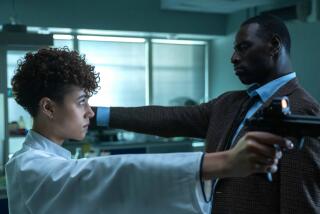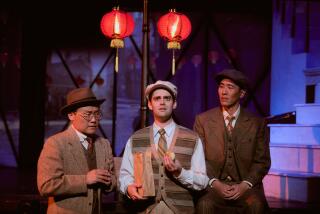An uneasy success
- Share via
She was the first Asian movie star in the West, and her career spanned four decades, bridging the silent films to talkies, and even venturing onto stage and into early television. Anna May Wong was a woman in the right place at the right time.
Born in Los Angeles to traditional Chinese parents in 1905, her star-struck ambition and her svelte good looks coincided with a taste for Oriental exotica on stage and screen in the U.S. and in Europe in the ‘20s and the ‘30s. Her career rose meteorically, yet she would find it hard to escape the crater of stereotyping into which she too easily tripped. “Rediscovering Anna May Wong,” presented by the UCLA Film and Television Archive from Friday through Jan. 25, includes 12 features from the apex of her stardom. They range from the silent film “Toll of the Sea” (1922), her first starring role, to “Shanghai Express” (1932), her most famous, to rarely seen B pictures like “Daughter of the Dragon” (1931) and “Daughter of Shanghai” (1937) that were her staple.
In the last decade several of these have been beautifully restored -- most recently “Piccadilly” (1929), which was Wong’s last silent film and one in which she plays a cheeky scullery maid who becomes the glittering headliner at a swank London nightclub. In this and countless other films, she does her obligatory Oriental-style shimmy, here a concoction with Thai and Balinese flavors, in a scanty Oriental-style costume while desire-filled white men look on.
“For a good 10 years she received top billing, she was a huge international star,” says Mimi Brody, who programmed the UCLA series. “For an Asian American actress there’s no comparison for the scope of her career.”
During World War ll, Wong announced her retirement and did fundraising for the United China Relief Fund. But she couldn’t stay away from show business and in the 1950s she made several television and movie appearances. She was gearing up for a movie comeback and was slated for a key role in the movie version of “Flower Drum Song” when she died of a heart attack in 1961.
Lotus Flower key role
Anna MAY WONG started out in the business taking on bit parts while still a teenager and living at home helping out in the family laundry business. Then she landed the starring role in “Toll of the Sea.” Set in some Hollywood-lot China and borrowing heavily from “Madame Butterfly,” the film had the young actress playing willowy Lotus Flower, who falls in love with a white merchant.
After impregnating her, the merchant abandons her, then later returns with his white wife. Naturally, Lotus Flower has to fling herself into the sea in disgrace, the first of many films in which Wong was obliged to die -- by her hand or at the hand of others -- by the close of the film. (Poisoning and stabbing were particularly popular denouements for her characters.) Sometimes she takes this drastic measure because of thwarted love, especially when she realizes she is no match for the white female interest of the white male hero (“Toll of the Sea,” “Java Head,” “Dangerous to Know”). For even though she entices the man, she rarely gets him, consistent with the contemporary bias that while miscegenation was titillating, it wasn’t really acceptable.
The actress’ next big break came from silent superstar Douglas Fairbanks, who cast her as the slave girl/Mongol spy in “The Thief of Bagdad” (not in the UCLA series). But while the film made her famous, she was slotted into a series of small roles in Hollywood until she decided to jump-start her career in Europe.
German director Richard Eichberg had offered her a five-picture film contract, and in 1928 she moved to Europe, chaperoned by her sister. Two years later she had learned enough German and French to make three versions of Eichberg’s “The Flame of Love” -- in English, German and French, with three different leading men.
When she finally returned to Los Angeles, she was in demand, eventually tallying some 60 features, most of which have been lost. Nearly all played heavily on racial and cultural stereotypes. During the Depression there was a huge appetite for foreign accents, foreign people and foreign locations, preferably with scenes of high living and untold luxury thrown in, but in the end the morality of the time would have to reassert itself.
Centennial approaches
The fascination for Anna May Wong continues, perhaps in anticipation of the 100th anniversary of her birth.
There are three new books about Wong: Anthony Chan’s “Perpetually Cool: The Many Lives of Anna May Wong (1905-1961)” was published last October, and soon to come are another biography, Graham Hodges’ “Anna May Wong: From Laundryman’s Daughter to Hollywood Legend,” and a well-researched reference book, Philip Leibfried and Chei Mi Lane’s “Anna May Wong: A Complete Guide to Her Film, Stage, Radio and Television Work.”
Chan, a former journalist who teaches at the University of Washington in Seattle, will give an illustrated talk about Wong at UCLA on Saturday. Speaking by phone, he acknowledges that Wong fell into highly stereotyped roles but admires what she achieved. “Through racism and patriarchy she was [still] able to succeed,” he says.
In fact, she succeeded partly because she played into racism and patriarchy, Chan believes. Typically, she was made up to look like a China doll, with straight-cut bangs, pencil eyebrows and heavy eyeliner, often dressed in some exotic get-up, high-neck tunics and embroidered robes. She had two main roles, each delivered in a highly mannered way: the Dragon Lady whose evil machinations cause death and destruction and the Lotus Blossom who’s all too eager to please her man.
Wong was aware of her uneasy position. As early as 1925 she said in a newspaper interview with the San Francisco Chronicle, “It is hard to get into the pictures, but it is harder to keep in them. Of course, it is nice enough if one gets a five-year contract as some of the actors do, but freelancing which I do is not easy. You see, there are not many Chinese parts.”
Now and then we get glimpses of what Wong was capable of and could have become had she had better material and better directors. Take her role as Hui Fei, the Chinese woman sharing a train compartment with the notorious Shanghai Lily (Marlene Dietrich), in “Shanghai Express.” While Wong had her usual sullen demeanor and few speaking lines, director Josef von Sternberg brought out the spark of her inner life. In one brief scene an elderly passenger barges in on them, announcing that she is running a “respectable” boarding house in Shanghai.
Wong, who has been calmly and resolutely playing solitaire, hands back the woman’s calling card with acid dripping in her voice: “I must confess I don’t quite know the standard of respectability that you demand in your boarding house, Mrs. Haggerty.” Toward the end of the film, she is playing solitaire again, this time after having exacted her revenge upon a rebel officer (Warner Oland, playing yellowface again) who has assaulted her. She throws down a card with emphasis. “Death has canceled his debt to me.”
Apparently, Dietrich thought she’d been upstaged by Wong. There are those who see this luminous film who might very well agree with her.
*
‘Rediscovering
Anna May Wong’
When: Friday through Jan. 25
Where: James Bridges Theater, 1409 Melnitz Hall, UCLA, Westwood
Price: $7-$8
Contact: (310) 206-FILM or www.cinema.ucla.edu/
More to Read
Only good movies
Get the Indie Focus newsletter, Mark Olsen's weekly guide to the world of cinema.
You may occasionally receive promotional content from the Los Angeles Times.










